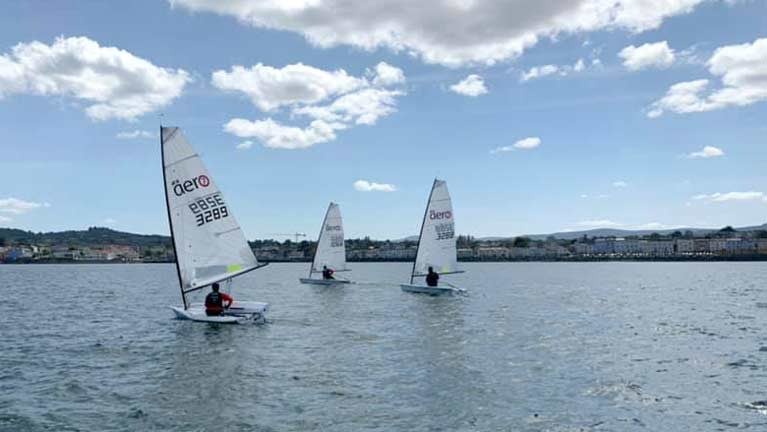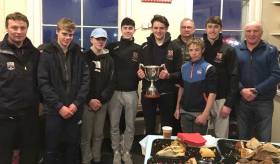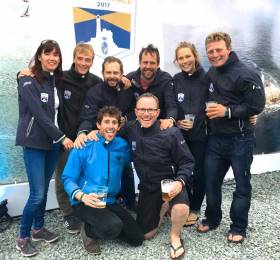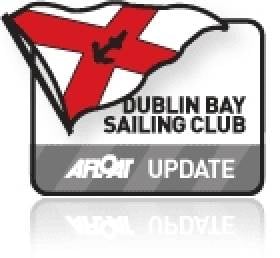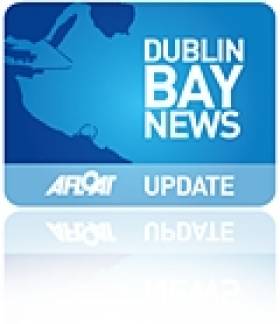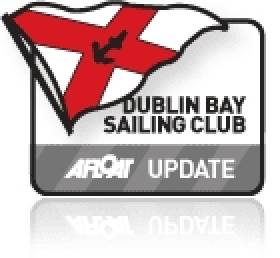Displaying items by tag: Irish National Sailing School (INSS)
Fireball Aces Join RS Aero Dinghy Fleet
The Irish RS Aero dinghy fleet grew by six over the last week and a half. The class now stands at over 20 boats and the Irish National Marine Services team handed over one of the demo boats for a trial only this morning.
“We are delighted to welcome the latest Aero sailors to the Irish Fleet. With 6 new boats launched this week and more on the way the class is set for great growth in 2020 - our new owners bring a great mix of fun, enthusiasm and great racing skills", says Brendan Foley Chairman RS Aero Ireland Association.
Recent additions to the class include Karl Leavy of Swords Sailing Club, who took possession of his new boat just in time for the lockdown to hit!
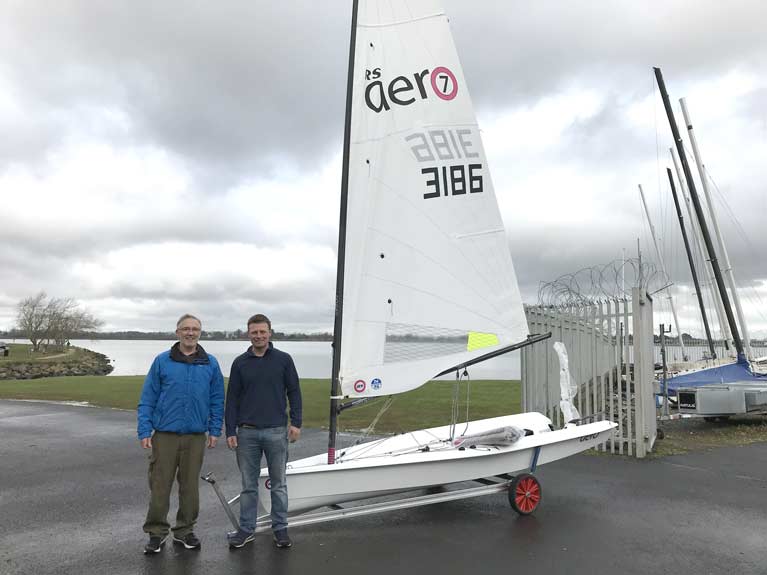 Karl (left) receives his new RS Aero from RS Sailing dealer Kenneth Rumball
Karl (left) receives his new RS Aero from RS Sailing dealer Kenneth Rumball
Only last week Rob Hastings of Bosun Bob’s delivered a new boat to Andrew Baker, while Irish National Marine Services supplied Fireball Aces Noel Butler and Stephen Oram a new boat apiece while Philip Trickett and Charlotte O’Kelly show how the various rig options can allow the whole family get use of the same boat! And it was only on Sunday when Daragh Sherridan took possession of his new Aero.
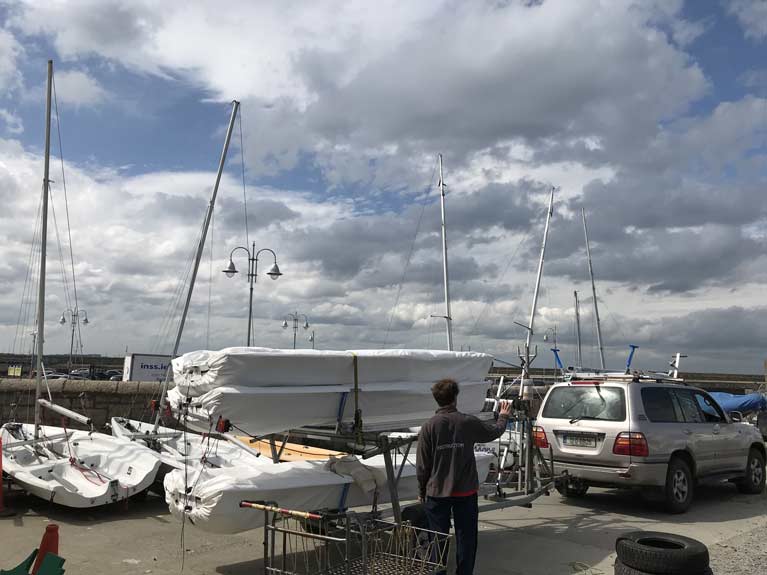 Three new Aero dinghies arrive in Dun Laoghaire Harbour
Three new Aero dinghies arrive in Dun Laoghaire Harbour
Currently, a large portion of the Dun Laoghaire fleet is based at the Irish National Sailing & Powerboat School while the sailing clubs are moving the cruisers off the decks. Indeed many of Dun Laoghaire’s dinghy sailors can call the coal harbour slipway home for a week or two, with regular sightings of sailors based on the Eastern side getting a taste of the marina fairway and “Hell’s Gates”. Glyn Williams of the Irish National Sailing & Powerboat School has been on hand as a safety boat operator for the Aero class and reports “Everyone is taking the new social distancing measures in their stride which is certainly encouraging for more activity afloat”.
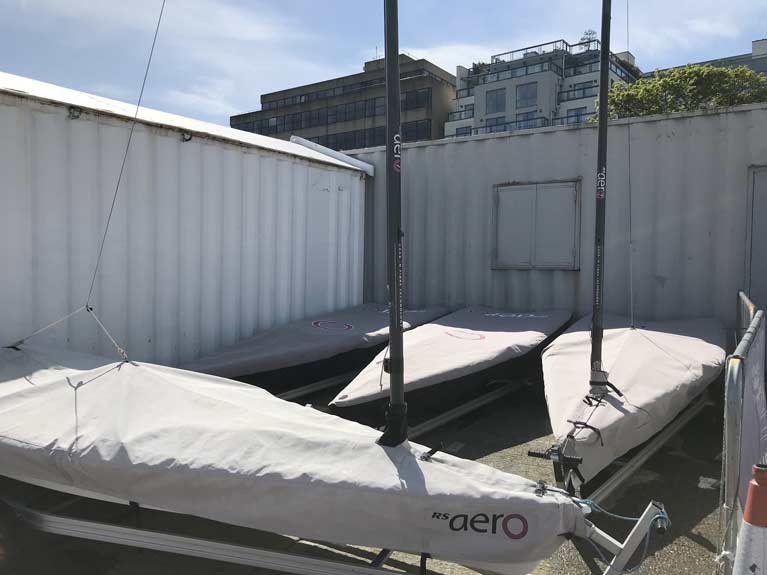 The temporary RS Aero Dun Laoghaire base nestled into the INSS patch in the Coal Harbour
The temporary RS Aero Dun Laoghaire base nestled into the INSS patch in the Coal Harbour
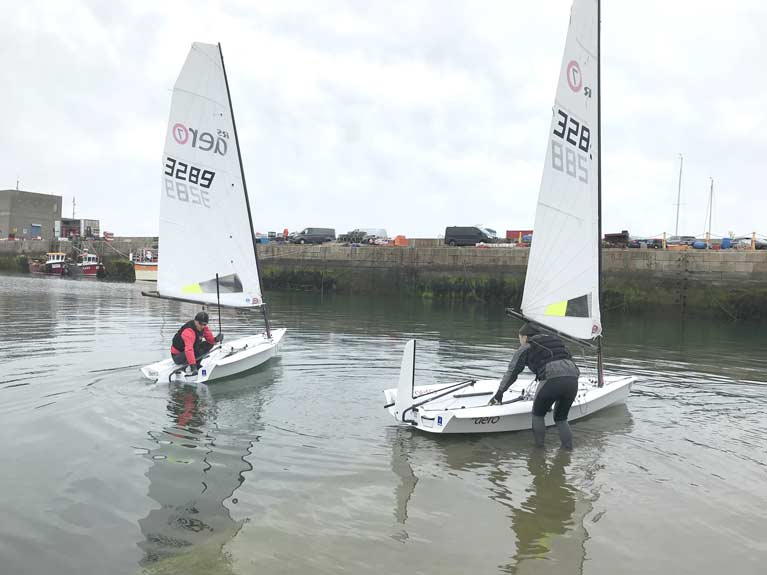 Fireball champions Noel Butler and Stephen Oram get afloat for the first time
Fireball champions Noel Butler and Stephen Oram get afloat for the first time
It’s now full steam ahead for the RS Aero Irish Open rescheduled to Saturday 19th and Sunday 20th September. While there has been some speculation as to why the date was chosen given the Laser Masters will be running the same weekend, the explanation is really rather mundane, it was when the RS Aero charter fleet was available. Enquires for charter Aeros can be sent to Kenny Rumball, [email protected], or to [email protected].
The gang all headed out on Sunday afternoon, making the most of the weekend’s excellent weather, with class chairman Brendan Foley providing RIB support as they got to grips with the new boats in Scotsman’s Bay. Some footage of the occasion was captured!
RS Aeros set sail on Dublin Bay - Video
Nine Teams from Six Dublin Schools Compete in the Inaugural Shanahan Team Racing Cup
Nine teams from six Dublin schools (Holy Child, Blackrock College, Loreto on the Green, Gonzaga College, St Gerard's and Loreto Foxrock) competed in the inaugural Gonzaga College/Irish National Sailing & Powerboat School school’s team racing event for the Shanahan Cup on 16 January 2019. Sailing in the Irish National Sailing & Powerboat School’s fleet of Topper Topaz Vibe dinghies, the teams faced testing conditions in a cold northwesterly wind which ranged from two to 20–knots.
Vincent Delany kicked off the day with a hugely informative briefing to all sailors before heading to sea as, for some. this was their first experience of team racing. After a short delay, the fleet assembled in the training area of Dun Laoghaire Harbour where the course was pre-laid and ready for action.
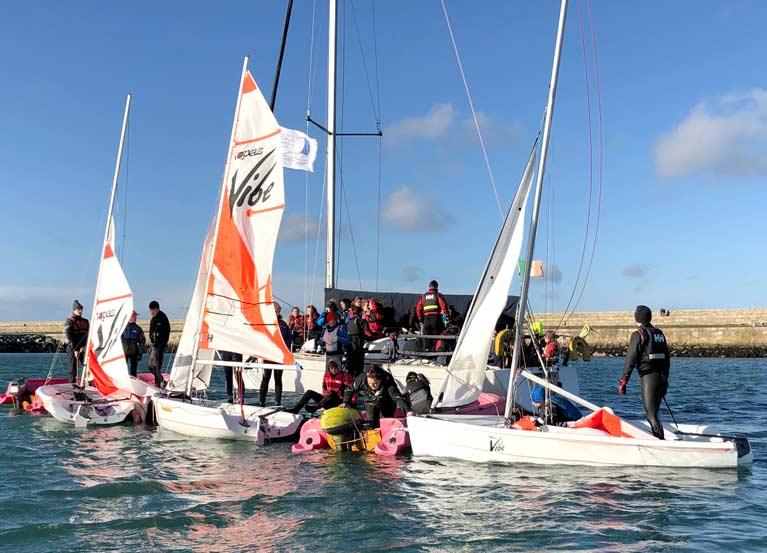 The Cup was sailed sailed in the Irish National Sailing & Powerboat School’s fleet of Topper Topaz Vibe dinghies
The Cup was sailed sailed in the Irish National Sailing & Powerboat School’s fleet of Topper Topaz Vibe dinghies
Notwithstanding that many of the young sailors had suffered dunkings during the numerous capsizes in the early races the youngsters seemed oblivious to the cold and a lively party continued all day on Lula Belle, one of the INSAPS’s fleet of cruising yachts which was tied alongside the pontoon in the training area of Dun Laoghaire Harbour. Hot chocolate and warm treats were on supply day round which gave sailors the chance to warm up ahead of their next race. The large pontoon ensured swift turnarounds of crews between dinghies before the next race.
Pool I was very closely fought and resulted in a three-way sail off between Blackrock College, Gonzaga B and Loreto on the Green, with Blackrock emerging as the victors.
Pool II was dominated by a powerful Gonzaga A team who won all their races and then faced Blackrock in the final. In a hotly contested start, Blackrock suffered an OCS of one of their boats which left them with too much catching up to do and Gonzaga emerged winners.
Speaking after the event Kenneth Rumball of the Irish National Sailing & Powerboat School emphasized the huge opportunities that existed in schools sailing. “Team racing represents a fantastic opportunity for young people to develop key sailing skills and to do it in a format that builds friendships and healthy rivalry between schools”
At the prizegiving, Fiachra Etchingham of Gonzaga College commended the high standard of sailing but emphasized that equally important was the younger and less experienced sailors who went out in difficult conditions and “gave it a go”.
Presenting the trophy Liam Shanahan encouraged the competitors not to focus too much on the results but to look at sailing as lifelong sport which afforded them opportunities to make friends and have fun.
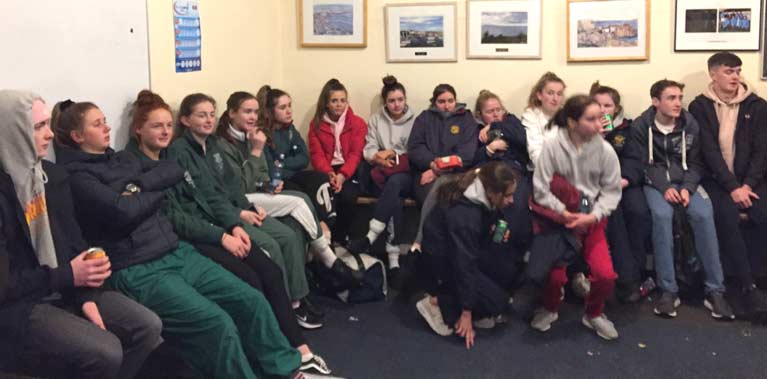 Nine teams from six Dublin schools (Holy Child, Blackrock College, Loreto on the Green, Gonzaga College, St Gerard's and Loreto Foxrock) competed in the inaugural Gonzaga College/Irish National Sailing & Powerboat School school’s team racing event
Nine teams from six Dublin schools (Holy Child, Blackrock College, Loreto on the Green, Gonzaga College, St Gerard's and Loreto Foxrock) competed in the inaugural Gonzaga College/Irish National Sailing & Powerboat School school’s team racing event
Dublin Secondary Schools are renowned for various sports and in particular for team sports. However, when one looks at the full range of sports played in Dublin schools, there are very few sports where girls compete against boys on equal terms. Sailing is one sport where they sail on equal terms.
50+ youngsters left the Irish National Sailing & Powerboat School with smiles on their faces looking forward to next year!
"not to focus too much on the results but to look at sailing as a lifelong sport which afforded them opportunities to make friends and have fun"
The event could not have taken place with mention of some key contributors. Fiachra Etchingham was the mastermind and instigator to which the event would not have taken place without his vision. Vincent Delany brought his considerable knowledge of team racing to ensure everything was set for the event to run smoothly as well as leading the team of highly experienced umpires. The Irish National Sailing and Powerboat School provided all the equipment facilities and logistical support. Liam Shanahan for his love of the sport sponsored the inaugural event.
The winning Gonzaga team was:
Jack Fahy, Andrew Conan
Henry Higgins, Finn Cleary
Tom Higgins, Con Murphy
Special thanks should go to the volunteers on the day comprising of;
Mark Delany, Tom Fitzpatrick, Trisha Kelly, Patricia Lawler, Michael Tyrell, Alistair Rumball, James Linton, Jill Fleming and a team of Gonzaga mothers who gave up the day out of their busy schedules to make the event such a success!
Alistair will be reliving 40 years of teaching tonight (Wednesday, the 18th of April at 8pm) at the INSS Clubhouse on the West Pier in Dun Laoghaire. As Afloat.ie previously reported, the talk is titled “A Life in the Irish National Sailing School”.
Alistair Rumball will recount the history of Ireland’s largest sailing school, from its humble beginnings on George’s Street in Dun Laoghaire to what it is today. He’ll recant as many of the stories from along the way as possible and talk a bit about his view for the future of sailing.
All are very welcome to attend.
Fastnet Race Justice for Irish National Sailing School's Jedi
With 312 entries in the IRC divisions alone, and numbers pushing towards the 400 mark when all classes are included, the record-breaking Fastnet Race 2017 was surely on the edge of becoming an unwieldy beast as it got under way in classic style westward down the Solent on Sunday August 6th. Add in the fact that the mountain of results was only being finalised on the following Friday, when the rhythm of the sporting week was already starting to bring major weekend arena events to the top of the demanding media agenda, and you inevitably have the prescription for a hasty allocation of subsidiary awards which risks seeing some trophies going to the wrong recipients. W M Nixon takes a look at how it all eventually came right in one very special case.
The Roger Justice Trophy is a handsome cup in the Rolex Fastnet Race array of silverware, yet it’s a cup for which nobody specifically competes. It goes to whichever offshore sailing school has done best in the overall results, and there were upwards of thirty boats eligible for it in 2017. But as Kenneth Rumball of the Irish National Sailing School tersely comments, if you’re racing a school boat in the Fastnet and you’re only interested in the Roger Justice Trophy, then you’re missing the point completely.
For as he sees it, the entire purpose of taking your training vessel in the Fastnet is to throw the tyro crew into open competition. You’re not seeking any special concessions because you’re a school boat. On the contrary, you’re there because this is the big boys’ game. You’re playing by the big boys’ rules. And you’re taking on the very best of them head-to-head, with no concessions expected.
 Head-to-head competition in the open fleet with no concessions expected. Jedi makes a dream of a port tack start in the Rolex Fastnet Race 2017. And yes, she did pass clear ahead of that boat (top left) romping in on starboard tack. Photo: Rolex/Carlo Borlenghi
Head-to-head competition in the open fleet with no concessions expected. Jedi makes a dream of a port tack start in the Rolex Fastnet Race 2017. And yes, she did pass clear ahead of that boat (top left) romping in on starboard tack. Photo: Rolex/Carlo Borlenghi
The story of how the Irish National Sailing School in its busy corner of the Inner Harbour of Dun Laoghaire came into being in the 1970s is now the stuff of legend. Our most recent detailed look at it came in this blog on 16th May 2015, when we headlined with an account of how school founder Alistair Rumball had expanded his additional advisory and boat provision role with the TV and movie business by organising the longships for the television series Vikings, thereby providing an additional income source to help the INSS through the depths of the economic recession.
In this he had the full support of his wife Muriel, who is the overall administrator of the school. And as it was a situation that demanded sacrifices in terms of working hours, pay and conditions which could never be expected from a non-family employee, their son Kenneth jacked in his job in Dublin as an accountant, and became the on-water principal.
By 2015 the light at the end of the tunnel had become a warm, steady and reassuring glow, and when we were there on a May evening, things were definitely on the up-and-up. In the basic but very functional premises, the first committee meeting of the recently-formed Irish National Sailing Club was being held. It had been set up in order to organize races and provide sailing school graduates with a club membership to comply with major event requirements, and to reflect that while the INSS was definitely a school, for many participants it had attractive elements of a club about it.
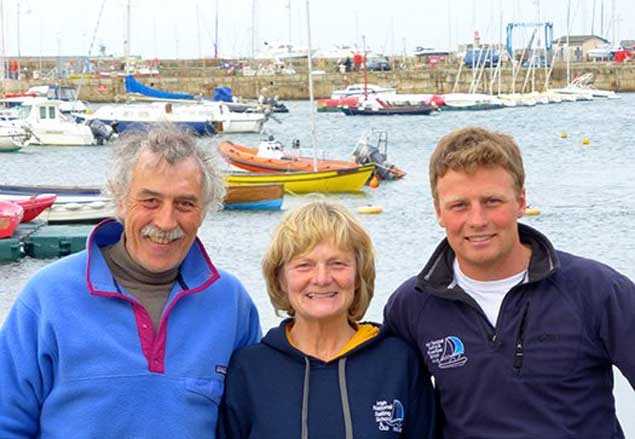 Alistair, Muriel and Kenneth Rumball – the family’s devoted work with the Irish National Sailing School has made an enormous contribution to Irish sailing. Photo: W M Nixon
Alistair, Muriel and Kenneth Rumball – the family’s devoted work with the Irish National Sailing School has made an enormous contribution to Irish sailing. Photo: W M Nixon
Alistair was busier than ever with Viking ships which had to be replaced from time to time just wherever he could find a builder who could comply with strict standards and a tight budget, and Kenneth was thinking ahead to further development of the uses of a fleet which included craft up to 1720s size, with the Reflex 38 Lynx in prospect as the school flagship with serious offshore racing possibilities.
In the intervening two and more years, many things have happened. Sadly, Alistair’s brother Arthur died much mourned in December 2016. He had been a cornerstone of the school structure as he was in charge of maintenance of the enormous, very varied and growing training fleet, but he’d trained his staff well, and his high standards have been maintained.
But by December 2016, the club’s fleet structure had been enhanced with the addition of the Reflex 38 which Kenneth had skippered to tenth overall in the fleet of 63 boats in the Volvo Round Ireland Race, winning the sailing schools division.
Yet despite this successful debut on what was now the international scene, they’d already concluded that the technically difficult Reflex 38 was not the ideal offshore racing boat for a Dun Laoghaire-based sailing school to make the best use of the unique combination of possibilities which Dublin Bay and its adjacent long distance racing areas provided.
Longterm readers of Afloat.ie don’t need reminding that we have been banging on for a very long time indeed about just how ideal is the J/109 to embody Dublin Bay’s noble One-Design tradition. So when word came through that the Irish National Sailing School had bought the 2002-built J/109 Jedi II with the aim of serious campaigning in the 2017 season, it was very good news indeed.
It’s the perfect package – a very manageable boat, straightforward to sail with a bowsprit and asymmetricals, plenty of sister-ships to pace yourself against offshore, and a cracking fleet in Dublin Bay to give INSS students a taste of inshore One-Design racing at its very best.
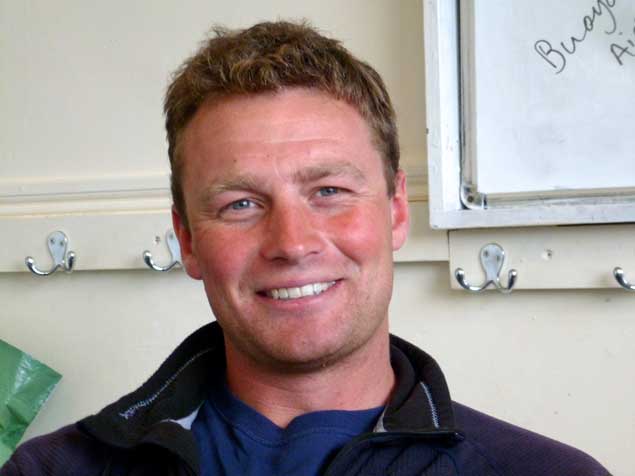 Kenneth Rumball in the INSS’s decidedly basic premises on Dun Laoghaire’s Inner Harbour this week. He took a 15-year-old J/109 and transformed her into a race winner. Photo: W M Nixon
Kenneth Rumball in the INSS’s decidedly basic premises on Dun Laoghaire’s Inner Harbour this week. He took a 15-year-old J/109 and transformed her into a race winner. Photo: W M Nixon
But there was much to be done to bring Jedi up to Kenneth Rumball’s demanding requirements. At 29, he was already a successful veteran of the Round Ireland, Fastnet, Middle Sea and Sydney-Hobart Races. So a year’s campaigning culminating in the Rolex Fastnet Race 2017 demanded a programme of painstaking remedial work to optimize Jedi for the serious stuff.
In doing this, he was helped by two things. Arthur Rumball’s legacy was a skilled workshop staff who could assist Kenneth in reducing superfluous weight in Jedi – in all, about 350 kilogrammes of unnecessary equipment and “ornaments” came out of her, while her underwater hull was taken down to the gelcost and her keel got a proper fairing. But as well, Andrew Algeo had also recently also joined the Dublin Bay J/109 fleet with the newer Joggerknot. He too was engaged in optimizing her for the high standard of racing of the Dun Laoghaire fleet, so between them they provided a real Brain’s Trust for the exchange and implementation of ideas.
At a high point in January 2017, it looked as if the INSS might have two boats in the Rolex Fastnet Race 2017. Kenneth had just come back from racing the Sydney-Hobart in a First 40, and was filled with enthusiasm for the potential of having the school’s two boats in the Fastnet. So he set up two Rolex Fastnet Race 2017s entry procedures side-by-side on two separate laptops on the school’s work table. There was just time to have everything in order as the closing date arrived, and for those who have had difficulty in even getting their Fastnet Race entry considered, it will be maddening to hear that both INSS boats made the cut.
But over the coming months, harsh reality intervened as the sheer logistics challenge of managing and manning two proper school entries from a base in Dun Laoghaire in a race starting off Cowes became apparent, and Lynx’s slot was returned to the RORC office.
Thanks to this slimming of the operation, things were looking very good for the season’s campaigning of the revitalized Jedi. Early races were providing increasingly encouraging results, and the places in the training programme towards participation in the Rolex Fastnet Race 2017 had been quickly snapped up and money paid up front by a diverse line-up of trainees. This meant they’d comfortably comply with the RORC’s fairly modest definition of a sailing school entry as a boat which was sailing school-owned, and had a 50/50 lineup between experienced and trainee crew.
It has to be remembered that this was all taking shape as the INSS was entering its busiest time of the year in its core activity of being a sailing school which gets hundreds of people from every background afloat in a wide variety of boats in Dublin Bay, a significant proportion of them for the very first time.
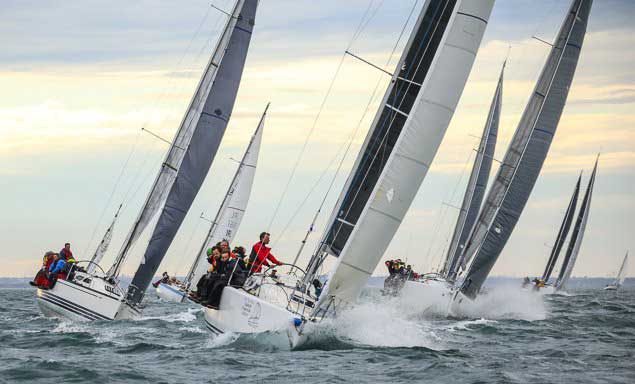 Jedi leading the offshore fleet. The combination of Dublin Bay One-Design sailing with the J/109s, combined with readily-available offshore racing, offers a superb opportunity to learn – but only for those who can stick the pace. Photo: Afloat.ie
Jedi leading the offshore fleet. The combination of Dublin Bay One-Design sailing with the J/109s, combined with readily-available offshore racing, offers a superb opportunity to learn – but only for those who can stick the pace. Photo: Afloat.ie
So it was a cruel blow when the wheels came off the Jedi programme on May 13th with the ISORA Holyhead-Dun Laoghaire Race. A rugged event with wind-over-tide conditions and the sea at its coldest, it may have seen hardened veterans like Paul O’Higgins and his tough crew in the JPK 10.80 Rockabill VI revelling in the going to win, and there was also good going by second-placed Transatlantic veteran Conor Fogerty in the Sunfast 3600 Bam. But aboard Jedi there was misery and seasickness rampant among the trainees, and at race’s end three of them pulled out of the Fastnet programme.
They’d already paid up, but in time an amicable financial settlement was reached, and Kenneth Rumball set about filling the empty places, though as the end of May approached, he was not feeling optimistic. Yet they managed to get a crew with the right configuration together for the vital Dun Laoghaire to Dingle Race on 11th June, seen as a key qualifier and training event, yet here too things went pear-shaped.
The unbelievably rugged beat round Ireland’s rocky southeast corner took a savage toll with wholesale retirals, and one of Jedi’s crew became ill beyond seasickness. It was feared they were having a stroke, and the whole purpose on board became focussed on getting into Dunmore East as quickly as possible and getting the casualty to hospital, where recovery was complete. But by the time that had been done, it was clear they were out of the race, and they sailed disconsolately back to Dun Laoghaire to pick up the pieces.
Fortunately the rest of the crew were still more than game for the Fastnet challenge, and they’d ISORA’s Lyver Trophy Race on June 30th before the Volvo Dun Laoghaire Regatta from 6th to 9th July to provide the final necessary qualifier. But the race was postponed because of a severe gale, put back to a date three weeks hence, which would leave the final Jedi qualifier only a narrow window of opportunity.
Yet suddenly, they were in a time of hope. Jedi with many of her potential Fastnet crew on board had a great Volvo Dun Laoghaire Regatta. They finished second in class, and the team were bonding in a very encouraging way.
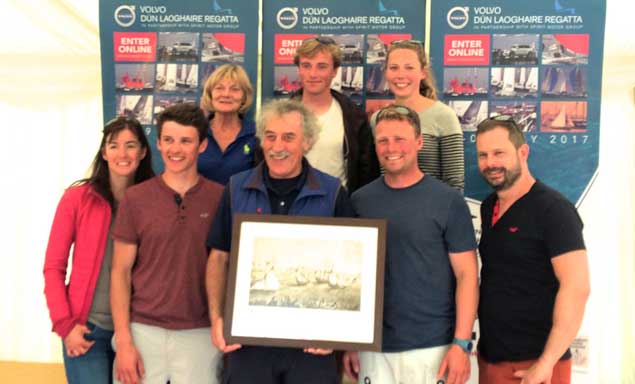 When it all finally started to come together. Alistair & Muriel Rumball with Jedi’s crew at the prize-giving ceremony for Volvo Dun Laoghaire regatta, July 9th 2017. To celebrate Dun Laoghaire’s 200th Anniversary, one of the prizes was a picture of the first regatta at the harbour, in 1828.
When it all finally started to come together. Alistair & Muriel Rumball with Jedi’s crew at the prize-giving ceremony for Volvo Dun Laoghaire regatta, July 9th 2017. To celebrate Dun Laoghaire’s 200th Anniversary, one of the prizes was a picture of the first regatta at the harbour, in 1828.
Two weeks later, the Lyver Trophy was sailed on July 21st from Holyhead round Rockabill to Dun Laoghaire, and they’d a good race of it. Although the winner was the all-conquering J/109 Sgrech (Stephen Tudor), Rumball and his crew were right in the thick of it chasing in a three-way match race with sister ship Mojito (Peter Dunlop & Vicky Cox), and they finished with the feeling that at last they had the basis of a proper Fastnet challenge, albeit with just a fortnight to go to the start.
So the fact that Kenneth Rumball finally filled in the form to define them as a sailing school entry with less than a fortnight to go to the start of the Rolex Fastnet Race 2017 may have had something to do with the subsequent initial post-race mis-allocation of an award. He himself regarded the sailing school thing as very secondary to the core Jedei theme of being in the midst of the main fleet, and in any case he had the prodigious logistical challenge of transferring the focal point of the campaign from the school office in Dun Laoghaire to the Solent.
In times long past, anyone doing the Fastnet Race expected to spend the days beforehand berthed in Cowes. But with current entry numbers and the Solent area’s overcrowded situation, being in Cowes is if anything a disadvantage for a campaign from Dublin with limited resources and very extended lines of communication. In the circumstances, the way the Jedi team handled this was real textbook stuff.
Time and personnel resources were of the essence, so they arranged for the boat to be delivered on a semi-professional basis to the relative peace and quiet of Mercury Yacht Harbour well up the Hamble River over on the Solent’s mainland shore. And while the rest of the crew flew over in time to allow three clear days for final preparation, Kenneth and Lorcan Tighe stocked up a mini-bus to double as shore transport and a workshop/storeroom, and they took the Holyead ferry and drove it post-haste to the Hamble
 Just ever so slightly nervous….Jedi crew in Mercury Yacht Harbour on the River Hamble early on the morning of the start of the Rolex Fastet Race 2017
Just ever so slightly nervous….Jedi crew in Mercury Yacht Harbour on the River Hamble early on the morning of the start of the Rolex Fastet Race 2017
Lorcan Tighe (17) may have been be Jedi’s most junior crewman in terms of age, but he was one of the most experienced on board. From Killiney in Dublin, his family is non-sailing though his dad is into scuba diving. But when he was just six, Lorcan took a week-long course at the INSS, and was hooked. So although he now has his own Laser based at the National YC, his heart stays with the INSS where he instructs evenings and weekends and during holidays (he’s in final year at Marian College in Ballsbridge). And he’s mad keen on the offshore thing, taking on the hugely challenging job of being the bowman on Lynx during the 2016 Volvo Round Ireland Race.
He’s a talented helmsman too, so he was very much on the “experienced sailor” side of the equation aboard Jedi, where the co-skipper with Kenneth Rumball was Conor Kinsella (28), who’s from Tullamore and works in finance.
As for the “trainees”, they were very much of the Ireland of today. Deirdre Foley works in banking, Kylie McMillan (29) is in financial consulting, Keith Kiernan (41) is in insurance, George Tottenham (38) is in windfarms, and Fearghus McCormack – whom Kenneth Rumball reckons to be about 40 – is Mine Host of that splendid establishment, the Merrion Inn in the heart of Dublin 4.
Kenneth Rumball is refreshingly non-ageist, so apart from Lorcan Tighe who put us right on his young age, all those ages are only guesses. And Rumball is also refreshingly dismissive of the whole experienced/trainee divide. As far as he and his shipmates were concerned, they were a team, they were crew together, they had a joint mission to perform and everyone was doing his or her very best, and that was all there was to it. There were emphatically no artificial them-and-us divisions on Jedi.
 Here we go…Jedi leaves the now-familiar surroundings of Mercury Yacht Harbour, heading for the start of the Fastnet Race
Here we go…Jedi leaves the now-familiar surroundings of Mercury Yacht Harbour, heading for the start of the Fastnet Race
After such a saga of setback and breakthrough, the Fastnet Race itself could have just been just the concluding chapter in an extraordinary tale of triumph over tribulation. But of course for Jedi’s crew, it was the pinnacle. And it was high adrenalin stuff from the start. Kenneth Rumball set out to take on the best of the opposition head-to-head, and he’d the great Carlo Borlenghi to photograph the moment when Jedi made the sort of clear-away port tack start that is inevitable in traditional Fastnet conditions, yet few manage it so well.
As for the race itself, Deirdre Foley speaks for all with her enthusiastic memories: “I loved every minute of it. Superior planning and attention to tactics/routes etc, a great crew – great sense of humour and craic……on water we had some great wind overnight on our return journey to Plymouth – what looked to be a full moon, nice sea state, Jedi flying along like the wind, for me the best part of a wonderful race”
Young Loran Tighe takes, as you’d expect, a mature overview despite his youth. After all, this is a guy who was working the foredeck of Lynx at the age of 16, racing through the night off Ireland’s Atlantic coast:
“It was great to get the chance to experience the Fastnet Race, but also everything that led up to it including the ISORA series and Volvo Dun Laoghaire Regatta. Great boat, good plan, and in the end, a crew put together that made a super season of it”.
As to the actual race, the irony of it is that it looked as though they were having their closest race with sister-ship Mojito from the other side of the Irish Sea but the reality of a fleet the size of the Fastnet is that you’ve races going on at every side of you, and in the end the way that conditions of tide, wind and whatever pan out will mean that boats a certain size, type, and rating cohort will win out.
Thus everything was going the way of Jedi and her cohort after beating out to the Fastnet in classic style. The overall leader on IRC at the Rock was the JPK 10.10 Night and Day (Pascal Loison), with fellow French skipper Noel Racine second in sister-ship Foggy Dew, while third was Ireland’s Paul Kavanagh in the vintage Swan 44 Pomeroy Swan.
Their ratings are 1.003, 1.002 and 0.985 respectively, which tells us much. Mojito at the stage was at he best place in the race, she was ninth overall rating 1.010, while Jedi was in contention, rating 1.008 and in 11th place overall, just one place ahead of RORC Commodore Michael Boyd of the RIYC racing the first 44.7 Lisa.
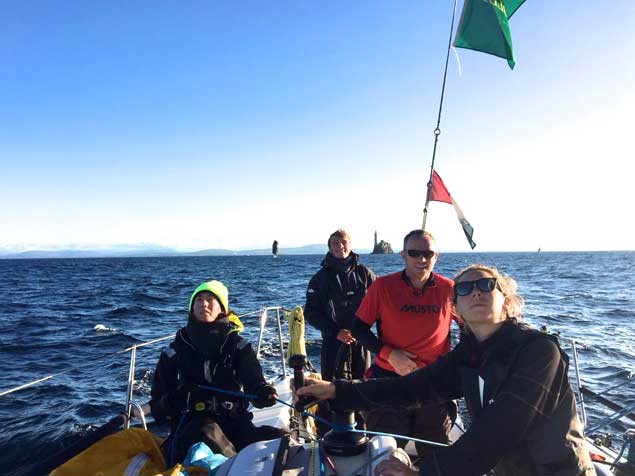 On top of the world….with 17-year-old Lorcan Tighe on the wheel, Jedi heads for Plymouth from the Fastnet Rock lying 11th overall in the 312-strong fleet
On top of the world….with 17-year-old Lorcan Tighe on the wheel, Jedi heads for Plymouth from the Fastnet Rock lying 11th overall in the 312-strong fleet
But on the fast sail back to Plymouth, it was boats around the 40ft mark which carried the favourable conditions best, and the JNA 39 Llan Ael 2 (Didier Gaoudoux, France) rose up the rankings from 29th overall at the Rock to become overall winner, while Lisa was remarkably consistent to move up from 12th to 8th.
But for the smaller J/109s, things became distinctly unfavourable, and though Jedi did indeed run like the wind, getting ahead of Mojito despite seeing her A3 blow out when it shouldn’t have, by the time she was in the final approaches to Plynouth the bite had long gone gone from the wind, and she cascaded down to 58th overall.
She was still very much the first J/109, and while she was 8th in IRC 3, she was first in IRC 3B for boats doing their first Fastnet. There was a cherished medallion in line for that, for a first in class in the greatest Rolex Fastnet Race ever held is something very special.
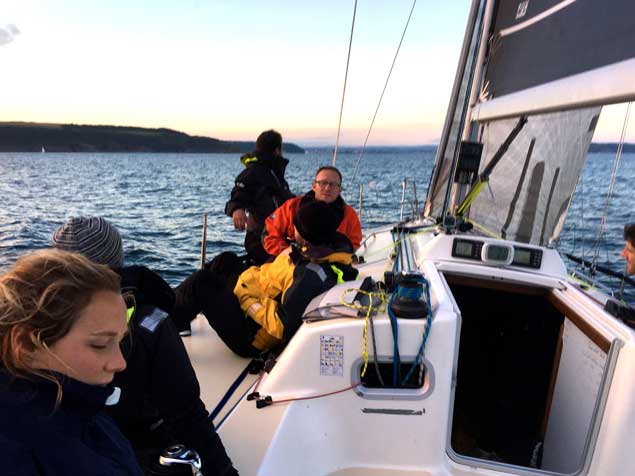 Aboard Jedi approaching Plymouth and the finish as night draws on, Thursday 10th August. The wind is slipping away, and she no longer holds a top overall placing, but is leading Class 3B.
Aboard Jedi approaching Plymouth and the finish as night draws on, Thursday 10th August. The wind is slipping away, and she no longer holds a top overall placing, but is leading Class 3B.
On that crowded Friday afternoon in Plymouth with mountains of results figures still being assimilated and analysed, the Roger Justice Trophy went to a Sailing School Farr 60. Something strange here. A scan of the results showed that Jedi been well ahead of that Farr 60 on corrected time. But with everyone going their various ways with Conor Kinsella heading off to retrieve the mini-bus from the Hamble while Kenneth Rumball cruised Jedi home, sorting it out could be left to a later date.
With that Class 3B win under their belt, there was time enough to see about putting the record straight. And when they later contacted the RORC office, they were told that there had indeed indeed been an error, and the winner of the Roger Justice Trophy was Irish Offshore Sailing of Dun Laoghaire in the Sunfast 37 Desert Star, thereby repeating Ronan O Siochru’s success of 2015.
So then they’d to get back to the number crunchers again, and gently suggest to them that it was indeed a Dun Laoghaire-based sailing school which had won the Roger Justice Trophy, but it was a different one - it was the Irish National Sailing School and the boat was called Jedi.
 Jedi gets Justice – RORC Commodore Michael Boyd, Committee Member Lucy Reynolds, and Kenneth Rumball as the Roger Justice Trophy finally reaches its rightful winner in RORC headquarters in London last week.
Jedi gets Justice – RORC Commodore Michael Boyd, Committee Member Lucy Reynolds, and Kenneth Rumball as the Roger Justice Trophy finally reaches its rightful winner in RORC headquarters in London last week.
It’s understandable that it happened. After all, Jedi’s final fully-qualified crew list as a sailing school was only submitted to the race office with about ten days to go to the start of the race. The sheer weight of data flying about by this stage must have been smothering for those handling it.
But it all came right at the end, though admittedly it was the very end. At an awards ceremony in the RORC in London last week, at the last moment Jedi was finally called forward to receive the Roger Justice Trophy. Forget that old saying about justice delayed is justice denied. In sailing, it’s acceptable if justice is done in due course, and is seen to be done.
Irish National Sailing School Traditional Currachs For Movie Role
Dun Laoghaire Harbour's Irish National Sailing School (INSS) fleet of six traditional Currachs (who knew?) are being transported this morning to the Wicklow mountains for a scene in Vikings, the hit historical drama television series written and created by Michael Hirst.
Unknown to many in sailing circles is the INSS's role in Irish film production, especially in movies involving waterbased scenes.
Corporate Sailing League Launched on Dublin Bay
Do you tell your friends or work colleagues all about your sailing adventures? Do they ask when you will bring them sailing or racing? Kenneth Rumball of the Irish National Sailing School thinks he may have the answer for you. The Irish National Sailing and Powerboat School is launching its all new Corporate Sailing League on Dublin Bay, the aim of which is to provide intercompany competition and networking through sailboat racing as a team on board a proven 1720 Sportsboat.
Our fleet of six 1720s are all identical having this year gone through a considerable refit. Therefore, the winning boat will be the one sailed to the best meaning teamwork is key to sucess. Our hope is that a keen competent sailor from a company will sell the idea to four of his colleagues to create a team of five to go racing against other companies and teams. For those teams that need some extra help, we will run a full training evening with the boats and if required provide a competent skipper/instructor as part of the team.
Sailing has proven globally how the sport can encourage teamwork amongst teams on the same craft while also providing great competition especially in one design boats which leads to great networking opportunities once back ashore after racing.
A series of short races will take place over five Tuesday evenings throughout the summer, 23rd May, 20th June, 18th July, 22nd August, 19th September. It is not necessary for the same team members or leaders to be present on each evening just make sure your company is represented! Racing will start at 1930 giving teams plenty of time to get out of the city to go sailing.
Après Sail: Growing and expanding business is hugely dependant on connections, forging new relationships, maintaining and building on existing contacts. Sailing is used worldwide by many of the elite companies in all sectors for this purpose. With many managing directors, CEOs and top businessmen sailing for pleasure and to keep business contacts alive. We see our new product essential for this purpose allowing up and coming associates in growing companies getting a step ahead to form new relationships. There will be a meal or BBQ after every evenings racing to facilitate this.
How does a company benefit? Any company can benefit hugely from this program by giving their employees the chance to form new business contacts and connections while also enhancing teambuilding on a thoroughbred race boat. In addition for every company that signs up to our program, we will get signs made with your company’s logo proudly displayed on our boats to give maximum visibility to a wide range of decision makers who sail regularly on Dublin Bay.
The cost of the programme is €1,500 per team
Dun Laoghaire's Irish National Sailing School has declared 'Summer 2015 a blast' – despite the weather. In fact, the country's biggest sailing school says the summer's weather was great for sailing. The video clip made by the school's Instructors shows just some of the INSS's 3,500 students enjoying the harbour under sail.
But with the Summer drawing to a close it doesn't mean the end of Children's Sailing, according to School Principal Alistair Rumball. The INSS Junior Club starts back on Saturday, 5th of September and runs thoughout the school term.
INSS 1720 Sportsboat Wins DBSC Spring Chicken Series
#inss – Nerves of anticipation on board Team INSS yesterday morning as our Race Training Programme got towed out in no wind to the start line of the added race to the Rathfarnham Ford DBSC Spring Series writes Kenneth Rumball of INSS. Team INSS were lying joint second overall going in to the last race with only a point to gain to win the series overall.
The team got out to the race course early as per series co-ordinator Fintan Cairn's instructions to observe a minutes silence in honour of Caroline Leonard prior to the last race.
With a light easterly breeze building Fintan and team wasted no time in laying a quick windward leeward course aided by the Team INSS support RIB to get the windward mark laid quickly. A favoured committee boat bias on the start line saw 'Third Time Lucky' (helmed by Ben Cooke), Team INSS and 'Wolfe' (RstGYC) all coming away tightly bunched from the start line. The two 1720s from the Royal St George tacked off early after the start toward the East Pier with Third Time Lucky, Team INSS and Lady A (RIYC helmed by Collie Byrne) all continuing on starboard tack. Team INSS was the first to peel off and on the return cross it was apparent the right hand side was more favourable as the two boat from the Royal St George crossed ahead of Team INSS, Third Time Lucy and Lady A. Merlin and Wolfe rounded the top mark first and second, Team INSS in third.
Team INSS put in a quick gybe after getting the kite up and settled. Sailing into slightly more breeze, Team INSS accelerated ahead and on gybing back into the leeward mark, Team INSS crossed comfortably ahead of the other 1720s. The second beat was quite uneventful with little place changing as Team INSS aimed to capitalise on their advantage. Heading downwind to the leeward mark with minutes before rounding, the signal was give from the committee boat Freebird for a shortened course. Just crossing the line, Team INSS managed to pass the lead Flying Fifteen to claim Line Honours for the days racing and with that the 2015 Rathfarnham Ford DBSC Spring Series.
This was a great achievement for the clients on board our race training programme. It also marks a great start to the Irish National Sailing Schools Cruiser race Training Programme in conjunction with the ISA and ICRA.
With the purchase of Martin Breen's 'Lynx Racing' the Irish National Sailing and Powerboat School can now provide the same high quality race training on board a state of the art cruiser racer covering various roles such as bow in greater detail. The purchase of Lynx also see the Irish National Sailing and Powerboat School as the newest Royal Yachting Association cruising school offering all cruising courses including Yachtmaster courses.
Coaching & Courses Make A Busy Start for Irish National Sailing School in Dun Laoghaire
#insc – It's been a busy last few weeks and weekends in the Irish National Sailing School based on the West Pier in Dun Laoghaire Harbour writes centre manager Kenneth Rumball. After wrapping up a successful DBSC Spring Series in the 1720 Sportsboats as part of our winter racing programme, our instructor trainees for 2014 were nearing their pre-entry exam for their Royal Yachting Association Dinghy Instructor Course. Not only were some candidates going forward for their RYA qualification but we also have been running many Irish Sailing Association Instructor Courses. If this wasn't enough for centre connections with ISA racing and also the Irish Fireball class, the Irish Fireball association held their class training programme in the INSS clubhouse. Coaches Simon Potts (and Kenneth Rumball) had the class out practising and fine honing a manner of skills to get themselves around the race track that bit quicker.
We are delighted to announce that for our second year in succession all 18 candidates on our RYA instructor course passed with flying colours. RYA traines, Alan Jones, Chris Gaskin, Nic Wymer and Geoff Stones all couldn't believe the standards of our ever improving junior sailors. With fantastic conditions, the RYA instructor course made the most of the weather with 'dummy' sessions being run every day on the water. After a thorough pre-assessment and 5 long days of making the transition from student to instructor, we are delighted to announce that all 18 candidates are now RYA dinghy instructors. The group will be taking a break after their long week before taking up instructing positions on our junior summer programmes this summer. The picture below shows the happy group just after receiving the news they successfully completed the course.

Running alongside this course was our second ISA instructor course of the year. Under pressure for the course to actually run and be a success, we are hugely grateful to Eddie English of SailCork.com for freeing up his busy schedule to come and run our course up in Dublin.
Finally if our instructor courses, coaching weekends and racing weren't keeping us busy enough, we have had some fantastic weekends of teaching courses for adults with almost 20 newly qualified sailors already this year... some of these sailors are already sailing in our club system allowing them to keep their new found hobby alive. But don't forget the Junior sailors who with the good weather we have had over the last week had a fantastic Easter sailing course in the warmest conditions so far this year, though some regretted the inevitable jump into the sea once they found out the sea temperatures haven't quite risen yet!
All in all we have had a fantastic start to the year and are looking forward to a fantastic summer ahead.
Team INSC 1720 Video at DBSC's Spring Chicken Series
#insc – 1720 sportsboat action on Dublin Bay in this new short vid from Team INSC that took part in the Dublin Bay Sailing Club (DBSC) Rathfarnham Ford Spring Chicken Series 2014. Full results here.




























